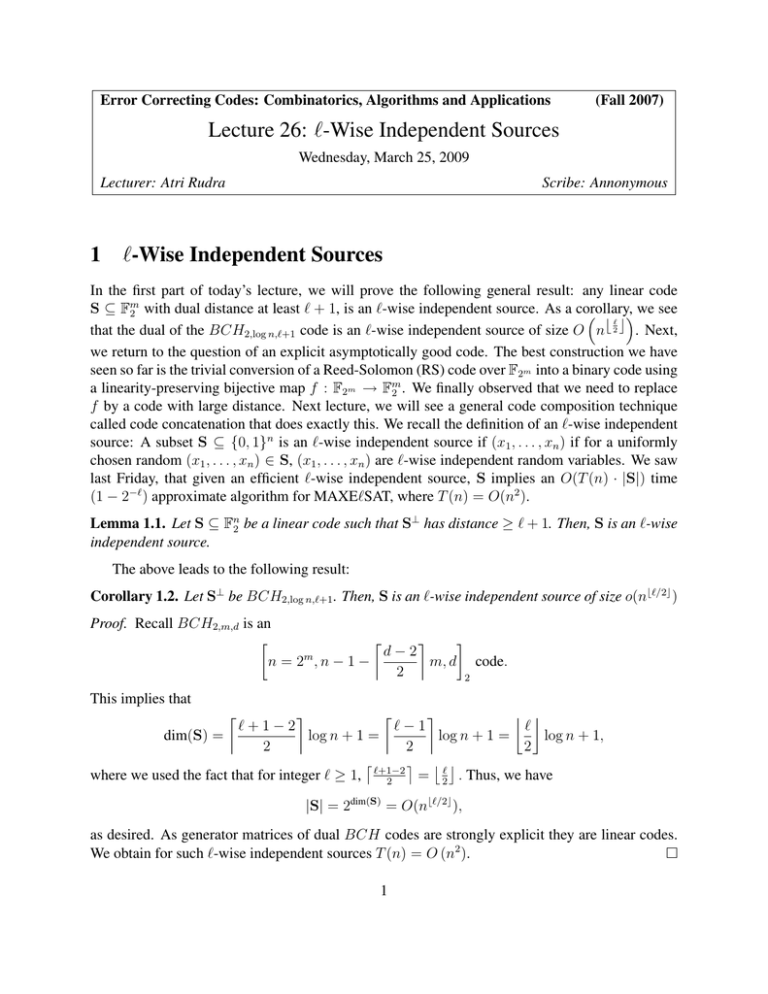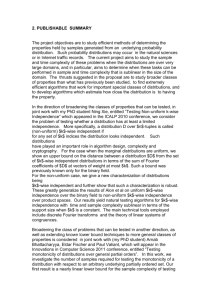Lecture 26: `-Wise Independent Sources
advertisement

Error Correcting Codes: Combinatorics, Algorithms and Applications
(Fall 2007)
Lecture 26: `-Wise Independent Sources
Wednesday, March 25, 2009
Lecturer: Atri Rudra
1
Scribe: Annonymous
`-Wise Independent Sources
In the first part of today’s lecture, we will prove the following general result: any linear code
S ⊆ Fm
2 with dual distance at least ` + 1, is an `-wise independent source. As a corollary,
` we see
that the dual of the BCH2,log n,`+1 code is an `-wise independent source of size O nb 2 c . Next,
we return to the question of an explicit asymptotically good code. The best construction we have
seen so far is the trivial conversion of a Reed-Solomon (RS) code over F2m into a binary code using
a linearity-preserving bijective map f : F2m → Fm
2 . We finally observed that we need to replace
f by a code with large distance. Next lecture, we will see a general code composition technique
called code concatenation that does exactly this. We recall the definition of an `-wise independent
source: A subset S ⊆ {0, 1}n is an `-wise independent source if (x1 , . . . , xn ) if for a uniformly
chosen random (x1 , . . . , xn ) ∈ S, (x1 , . . . , xn ) are `-wise independent random variables. We saw
last Friday, that given an efficient `-wise independent source, S implies an O(T (n) · |S|) time
(1 − 2−` ) approximate algorithm for MAXE`SAT, where T (n) = O(n2 ).
Lemma 1.1. Let S ⊆ Fn2 be a linear code such that S⊥ has distance ≥ ` + 1. Then, S is an `-wise
independent source.
The above leads to the following result:
Corollary 1.2. Let S⊥ be BCH2,log n,`+1 . Then, S is an `-wise independent source of size o(nb`/2c )
Proof. Recall BCH2,m,d is an
d−2
m
n = 2 ,n − 1 −
m, d code.
2
2
This implies that
`+1−2
`−1
`
dim(S) =
log n + 1 =
log n + 1 =
log n + 1,
2
2
2
`
where we used the fact that for integer ` ≥ 1, `+1−2
= 2 . Thus, we have
2
|S| = 2dim(S) = O(nb`/2c ),
as desired. As generator matrices of dual BCH codes are strongly explicit they are linear codes.
We obtain for such `-wise independent sources T (n) = O (n2 ).
1
Next, we move to the proof of Lemma 1.1. To do this, we recall a property of linear codes that
we proved earlier in the course:
Lemma 1.3. If C⊥ has distance d, then any d − 1 columns in a generator matrix for C are linearly
independent.
Proof. Lemma 1.1: First, recall that one way to think of a field element, is by defining a map
β 7→ α · β. If β is represented by its linear representation, α is a linear map from F`2 to F`2 . If
the linear representation L is fixed, then corresponding to α, we can define a map Mα : F`2 → F`2 ,
with Mα (L (β)) = L (α · β). Note that this map satisfies Mα (L (β) + L (γ)) = Mα (L (β)) +
Mα (L (γ)). Since this is a linear map, this means that ∃Mα ∈ Fk×k
such that Mα (x) = xMα . In
p
this case, Mα1 ·α2 = Mα1 · Mα2 and Mα1 +α2 = Mα1 + Mα2 . So addition and multiplication in the
field are just addition and multiplication of matrices. Let x ∈ Fk2 be a 1 × k vector such that
x = [x1 |x2 ],
when x1 ∈ F`2 and x2 ∈ Fk−`
2 . This means that x1 is a 1 × ` vector, and x2 is 1 × (k − `) vector.
Making x a 1 × k vector. Let y ∈ Fn2 be an (` + l0 + l1 ) × 1 vector such that
y0
y = y` .
y1
Note that y0 is l0 × 1 and y1 is l1 × 1. Let G = [G0 |G` |G1 ] be any generator matrix for S. With
G0 a k × l0 matrix and G1 a k × l1 matrix, G is a k × (` + l0 + l1 ) matrix with rank(G` ) = `.
x·G = yT , from Lemma 1.3. Next note that any k ×` matrix M of rank `, with k ≥ `, x·G = yT
takes every value in F`2 the same number of times ∀x ∈ Fk2 . Let
M1
M=
,
M2
be a k × ` matrix such that M1 is ` × ` and M2 is (k − `) × `. Then form x · M = yT ∈ F`2 , with
2k−` choices. x1 M1 + x2 M2 = yT , or x1 M1 = y − x2 M2 , and there is exactly one solution to
x1 M1 = b since M1 has full rank.
2
The R Versus δ Question
Let us go back to the R versus δ question. We will now recollect all the explicit families of binary
codes that we have seen so far and record the rate and relative distance they achieve. Can we
find any explicit asymptotically good linear codes, with polynomial or log-space construction?
Consider Hadamard codes:
log n
1
,δ= .
R=
n
2
2
For dual BCH2,log n,2t+1 codes, we have:
R∼
t log n
1
, δ = − n−(t−1)
n
2
This follows from the Weil-Carlitz-Uchiyama bound, which we state next.
Theorem 2.1. Weil-Carlitz-Uchiyama bound: Any non-zero codewords in the dual of the BCH2,m,2t+1
has Hamming weight w such that
2m−1 − (t − 1)2m/2 ≤ w ≤ 2m−1 + (t − 1)2m/2 ,
provided 2t − 2 < 2m/2 . All non-zero Hamming weight:
1
1
∈ ( − n−(t−1) , + n−(t−1) ).
2
2
However, none of the codes above are asymptotically good. On the other hand, consider the
Hamming code, for which we obtain
R=1−
3
log n
,δ= .
n
n
Also, for BCH codes, we obtain the following for any constant t ≥ 1:
R=1−
2t + 1
t log n
,δ=
.
n
n
For a family of codes called Reed-Muller (RM) codes, which we have not studied so far, we can
get:
1
1
R= , δ= √ .
2
n
Recall that RS codes are evaluations of univariate polynomials of bounded degree. RM codes
are generalizations of RS codes in that they are evaluations of multivariate polynomials over the
underlying Fq . The Hadamard code is a special case where the degree of the polynomial is equal
to 1. RS codes are asymptotically good codes but we have q = n = 2m . Unlike RS codes, RM
codes can be defined over any Fq including q = 2. Consider the case with q = 2n , and we have
an RS code of rate RRS and relative distance δRS : (RRS , δRS ). A trivial conversion to a binary
BCH2,log n,`+1 code gives
δRS
.
R = RRS , δ =
log n
With C1 and C2 ∈ RS:
C1 = (c0,1 , . . . , α, . . . , cm,1 )
C2 = (c0,2 , . . . , β, . . . , cm,2 )
Recall that a RS code over F2m can be converted into a binary code using a linearity-preserving
bijective map f : F2m → Fm
2 . The problem is that if α 6= β, all we can guarantee is that
∆(f (α), f (β)) ≥ 1. To solve this problem, pick f to be a code with a large distance.
3






